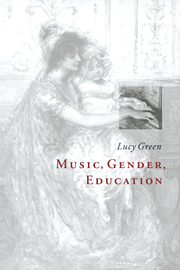Book contents
- Frontmatter
- Contents
- Acknowledgments
- 1 Introduction
- PART I MUSICAL MEANING AND WOMEN'S MUSICAL PRACTICE
- 2 Affirming femininity: women singing, women enabling
- 3 From affirmation to interruption: women playing instruments
- 4 Threatening femininity: women composing/improvising
- 5 Towards a model of gendered musical meaning and experience
- PART II GENDERED MUSICAL MEANING IN CONTEMPORARY EDUCATION
- Bibliography
- Index
2 - Affirming femininity: women singing, women enabling
Published online by Cambridge University Press: 20 November 2009
- Frontmatter
- Contents
- Acknowledgments
- 1 Introduction
- PART I MUSICAL MEANING AND WOMEN'S MUSICAL PRACTICE
- 2 Affirming femininity: women singing, women enabling
- 3 From affirmation to interruption: women playing instruments
- 4 Threatening femininity: women composing/improvising
- 5 Towards a model of gendered musical meaning and experience
- PART II GENDERED MUSICAL MEANING IN CONTEMPORARY EDUCATION
- Bibliography
- Index
Summary
DISPLAY AS A PART OF MUSICAL PERFORMANCE
In this section I will suggest that musical performance which takes place in full view of an audience normally contains an element of display. But first, I will present an interpretation of the nature of display itself, quite apart from music. It is helpful to understand display as involving something metaphorically akin to wearing a mask. In these terms, the displayer can be seen as both presenting and protecting himself or herself by virtue of the mask. The mask is then that which is displayed. But display is not so much a single act by a displayer as a relationship, an exchange which is mutually constructed by both the displayer and an onlooker. The mask cannot be imagined by the displayer as something known only to him- or herself; on the contrary, the displayer must be aware of an other, the onlooker, who is also conscious of the mask. The presence and watchfulness of this other are a necessary part in what is a mutual construction of the metaphorical mask. For each participant – displayer and onlooker – the scenario cannot exist without the other. But this is not a mere truism: it is the essence of the relationship, its focal point and raison d'être.
The mask has an effect of splitting the displayer in two. From the point of view of the onlooker, the displayer takes on a double form, as both ‘other’ and ‘mask’ from the point of view of the displayer, the self is doubled into ‘self’ and ‘mask’.
- Type
- Chapter
- Information
- Music, Gender, Education , pp. 21 - 51Publisher: Cambridge University PressPrint publication year: 1997



